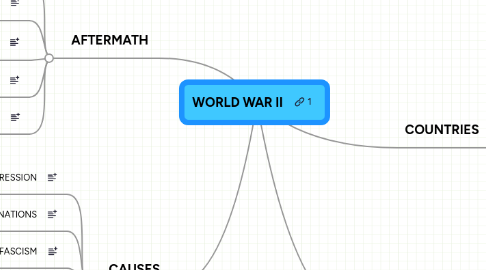
1. AFTERMATH
1.1. END OF NAZISM
1.1.1. Convert the interface of a class into another interface clients expect. Adapter lets classes work together that couldn't otherwise because of incompatible interfaces.
1.2. COLD WAR BETWEENUSA AND SOVIET UNION
1.2.1. Decouple an abstraction from its implementation so that the two can vary independently.
1.3. RISE OF USA AND SOVIET UNION AS SUPERPOWERS
1.3.1. Compose objects into tree structures to represent whole-part hierarchies. Composite lets clients treat individual objects and compositions of objects uniformly.
1.4. UNITED NATIONS ESTABLISHED
1.4.1. Attach additional responsibilities to an object dynamically. Decorators provide a flexible alternative to subclassing for extending functionality.
1.5. CIVIL WAR RESUMED IN CHINA
1.5.1. Provide a unified interface to a set of interfaces in a subsystem. Facade defines a higher-level interface that makes the subsystem easier to use.
1.5.1.1. Simple Interface
1.5.1.2. Hide complexity
2. CAUSES
2.1. WORLDWIDE GREAT DEPRESSION
2.1.1. Provide an interface for creating families of related or dependent objects without specifying their concrete classes.
2.2. FAILURE OF LEAGUE OF NATIONS
2.2.1. Define an interface for creating an object, but let subclasses decide which class to instantiate. Factory Method lets a class defer instantiation to subclasses.
2.3. FASCISM
2.3.1. Separate the construction of a complex object from its representation so that the same construction process can create different representations.
2.4. JAPANESE EXPANSION
2.5. NAZISM
2.5.1. used to manage the object caching
2.6. DEFECTS OF TREATY OF VERSAILLES
2.6.1. Specify the kinds of objects to create using a prototypical instance, and create new objects by copying this prototype.
3. WAR CRIMES
3.1. HOLOCAUST
3.2. ATTACK ON PEARL HARBOUR
3.3. BATTLE OF STALINGARD
4. COUNTRIES
4.1. GREAT BRITAIN
4.2. FRANCE
4.2.1. Define an object that encapsulates how a set of objects interact. Mediator promotes loose coupling by keeping objects from referring to each other explicitly, and it lets you vary their interaction independently.
4.3. SOVIET UNION
4.4. UNITED STATES
4.4.1. Define a one-to-many dependency between objects so that when one object changes state, all its dependents are notified and updated automatically.
4.5. GERMANY
4.5.1. Define a family of algorithms, encapsulate each one, and make them interchangeable. Strategy lets the algorithm vary independently from the clients that use it.
4.6. JAPAN
4.7. ITALY
4.7.1. Represent an operation to be performed on the elements of an object structure. Visitor lets you define a new operation without changing the classes of the elements on which it operates.
4.7.1.1. Single-Serving Visitor
4.7.1.2. Hierarchical Visitor
